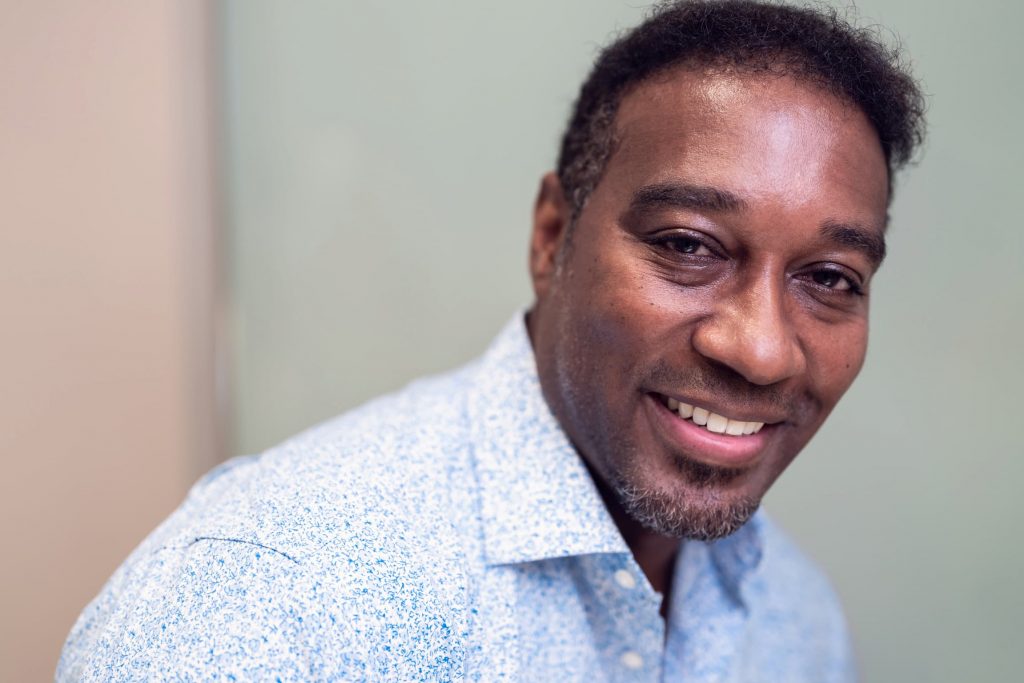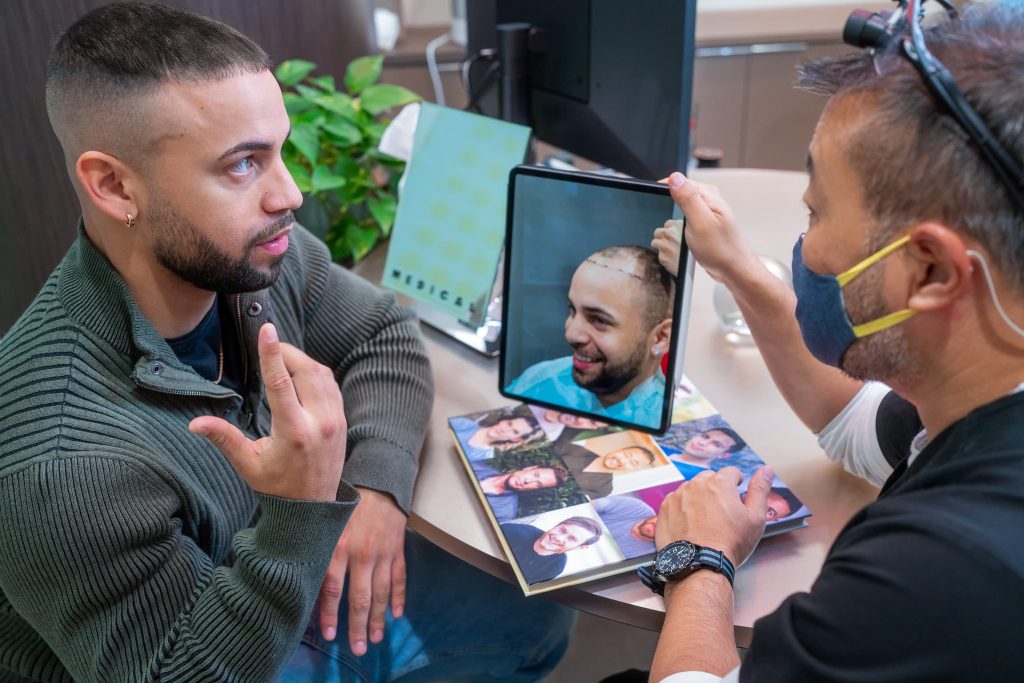
Actual Patient of Jae Pak, M.D
Hairline restoration is a hot topic to this day, and while huge advancements have been made, there are still a lot of questions that need answering by the general public.
If you’re diving into the topic for the first time, whether it’s out of pure curiosity or concern about your own hair loss situation, we are here to help with a comprehensive guide.
We’ll cover a complete overview of the hair restoration universe, from the most basic and natural remedies to the technologically advanced tools used by the world’s most exclusive clinics.
Let’s learn about what it takes to find the best hair restoration treatment for your needs, team up with a clinic you can trust, and how you can maximize your results for the long term.
Hair restoration does not refer to a single type of treatment or surgery. It isn’t one category of medicine or therapy that doctors use to save or restore hair.
The most accurate way to define hair restoration is in broad strokes. The term encompasses the full spectrum of treatments, medicines, therapies, and techniques used to address the issue of hair loss in all its forms. Surgical, non-surgical, experimental – it all falls under this umbrella.
When we explore the topic of hair restoration, we’re covering a wide range of topics and ideas that have been developing for centuries, ranging from strict clinical trials to anecdotal evidence and personal experience.
Additionally, hair restoration is an extremely personalized practice, opposed to a one-size-fits-all game plan that guarantees results for all people.
Hair loss occurs for various reasons, such as androgenetic alopecia (the usual genetic cause of pattern balding), poor diet and lifestyle choices, autoimmune disorders like alopecia areata, or hormone imbalances resulting from non-related medication.
In the field of hair restoration, we also must account for clients’ different goals and priorities, whether they are to preserve existing hair, improve the condition of thinning hair, or even restore a hairline in its entirety.
Rather than viewing hair restoration as one type of treatment or strategy, we urge you to broaden your view of the concept and consider the wide variety of methods used to address hair loss on multiple levels and from various angles.
As scientists and doctors push forward on the front lines of hair restoration, we grow more confident and optimistic in our ability to help people achieve and preserve their desired look.
However, we also must remind clients and patients about what hair restoration is not, which sometimes means tempering sky-high expectations and giving some insight into the realities of hair restoration in practice.
While we aim to promote transparency and honesty in our practice, the hair restoration industry at large needs to do a better job at setting realistic expectations for clients, rather than making over-the-top claims about what can be done for their hair.
This is not to say that miraculous results can’t be achieved. With proper planning and execution, the right combination of treatments and procedures may lead to amazing outcomes.
Just keep in mind that nothing is 100 percent certain when it comes to hair restoration or any surgical procedure, and it’s always better to have an open, honest dialogue with patients about goals and expectations in the near and long term.
As we’ve mentioned, hair restoration covers a lot of different subcategories in science, technology, theory, and practice. Let’s learn about the different types of hair restoration and the positives and negatives that come with them.
While some might not consider this a legitimate category of hair restoration, it should absolutely be part of the mainstream conversation.
In fact, making smart lifestyle choices should always be the very first step taken for anyone looking to preserve, improve, or restore their hair.
This doesn’t necessitate a total lifestyle overhaul, and even small shifts can make a big difference in the strength and longevity of your hair.
Focusing on a balanced diet (protein and healthy fats) should be a primary focus here, in addition to moderate daily exercise and stress reduction if possible.
Natural supplements like collagen are plentiful and can indeed help restore the quality of hair, skin, and even gut health. Many people have also found success with essential oils like tea tree, lavender, mint, and more.
Thousands of advanced hair care products have been brought to market in recent years, offering more science-based solutions to hair restoration without the need for advanced therapies or medical treatments.
The active ingredients in these products vary based on the individual’s goals and what they have perceived to cause their hair loss.
DHT-blocking shampoos may prove most effective for men, while other products offer higher concentrations of compounds like Collagen, Biotin, Keratin, and others.
The advantage of these products is their availability and price, which allows most people to try out a range of different items and see what works best for them.
On the other hand, research may be lacking for many of these products, and to see results, consistency is key. No matter what hair restoration method you choose, it’s important to stick with a plan long-term instead of just dabbling.
While there are only two FDA-approved medicines for hair loss – Finasteride and Minoxidil – they both have strong support from clinical trials and have plenty of anecdotal evidence from millions of cases around the world.
Finasteride is a powerful DHT blocker that works to counteract the effects of this hormone at higher concentrations in the male scalp. Since too much DHT can shorten hair life cycles and lead to miniaturization, Finasteride can stop hair loss or reverse the trend.
Another advantage of Finasteride is convenience in the form of a once-daily pill. However, since it interacts with male hormones exclusively, it cannot be used for hair loss in women.
Minoxidil is a topical medicine better known as Rogaine. It works as a vasodilator, promoting blood flow on the scalp and jumpstarting the life cycles of follicles in the target region.
This medicine is the world’s most popular hair restoration product, although it requires a twice-a-day application to the scalp, which takes some time and technique.
Minoxidil can also be effective for women, although research shows that better results are achieved on the top of the head (vertex) rather than the hairline.
Patients considering these medications should be aware that these treatments must be continued indefinitely to maintain results. Coming off Finasteride or Minoxidil will eventually result in the loss of any hair loss restoration gains made during treatment.
Still, in terms of cost-effectiveness and overall efficacy, these two medicines should certainly be considered part of any hair restoration protocol.
Many therapeutic techniques have been introduced in just the past decade, proving that the hair restoration field is making strides across the board.
One of the most popular new methods is called low-level laser light therapy, which stimulates hair growth and promotes healthy skin with targeted near-infrared wavelengths.
Another technique growing in popularity is microchanneling, a non-surgical procedure that creates microscopic incisions in the scalp to stimulate collagen production and promote hair growth.
Microchanneling also helps the absorption of topical medicines and serums into the skin, accelerating the hair growth and healing process.
More experimental methods for hair restoration are also being worked on, including platelet-rich plasma and stem cell therapies but the research is not conclusive.
There needs to be more research done on these new techniques to see if they are truly effective for hair restoration, and they are also relatively expensive at the moment.
But if patients are willing to spend a bit of extra money and venture into the frontier of hair restoration without a strong basis of scientific support, these methods may prove to be highly rewarding despite minor risks.
When most people think of hair restoration, they consider surgical techniques like hair transplantation, hairline lowering, and other advanced techniques.
The most widely practiced hair transplant procedure is a follicular unit transplant or strip surgery. This technique involves the removal of a horizontal strip of hair-bearing skin from a donor area at the back of the head, then individual follicles from that strip are implanted to the top or front of the scalp as needed.
Follicular unit excision is the newer, updated version of hair transplantation that selects donor follicles individually to be implanted to the target region. The advantage of FUE is that the technique doesn’t create a linear scar on the back of the head like strip surgery methods. However, shaving the back and sides of the scalp is required.
Other surgeries like hairline lowering and forehead reduction can be powerful for patients who are happy with the shape of their hairlines but want to make their facial proportions more aesthetically balanced.
More clients are also seeking a technique called Scalp MicroPigmentation, which uses a precise tattooing technique to create the appearance of closely-shaved hair on the scalp or create an illusion of thicker hair.
Remember – surgery is only to be considered after the previous four categories of hair restoration have been tried since these advanced procedures can be costly and time-consuming.
Schedule a Consultation with Jae Pak, M.D. to speak about your hair restoration options.
Request a Consultation
The field of hair restoration has changed lives for the better in the 21st century, thanks to so many fantastic discoveries and techniques.
No matter how you choose to approach hair restoration, it’s always better to get ahead of the problem rather than wait until later. Team up with Jae Pak, MD, and his staff of expert technicians to create a custom strategy and do hair restoration the right way.
Sources:
Treatments for Hair Loss | ISHRS
Hair Loss Treatment | Mayo Clinic
Hair Transplant: How Does It Work, Success Rates | Cleveland Clinic
Speak with Jae Pak, M.D. today!
Request a Consultation